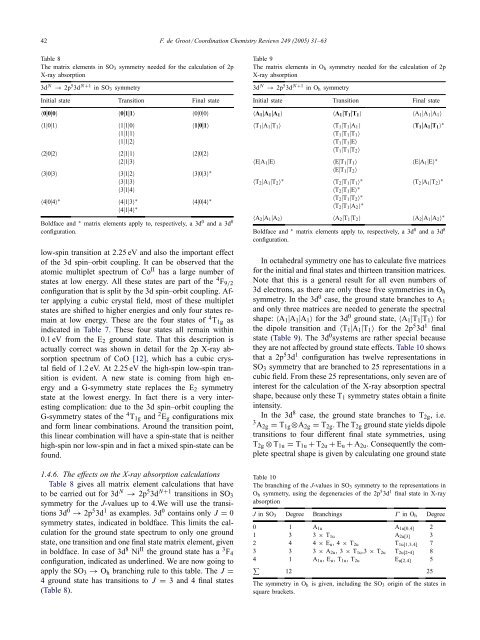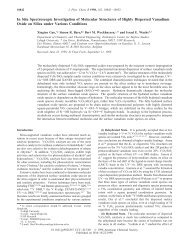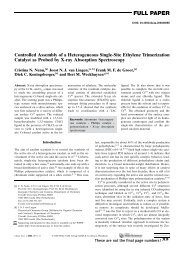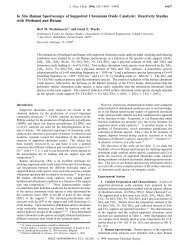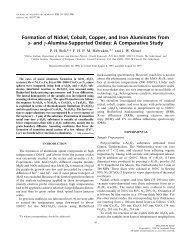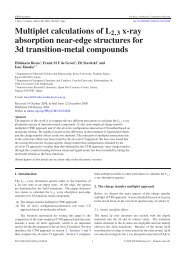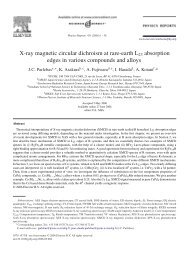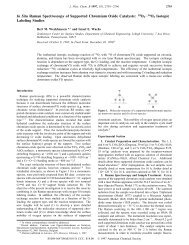Multiplet Effects in X-ray Absorption - Inorganic Chemistry and ...
Multiplet Effects in X-ray Absorption - Inorganic Chemistry and ...
Multiplet Effects in X-ray Absorption - Inorganic Chemistry and ...
You also want an ePaper? Increase the reach of your titles
YUMPU automatically turns print PDFs into web optimized ePapers that Google loves.
42 F. de Groot / Coord<strong>in</strong>ation <strong>Chemistry</strong> Reviews 249 (2005) 31–63Table 8The matrix elements <strong>in</strong> SO 3 symmetry needed for the calculation of 2pX-<strong>ray</strong> absorption3d N → 2p 5 3d N +1 <strong>in</strong> SO 3 symmetryInitial state Transition F<strong>in</strong>al state〈0|0|0〉 〈0|1|1〉 〈0|0|0〉〈1|0|1〉 〈1|1|0〉 〈1|0|1〉〈1|1|1〉〈1|1|2〉〈2|0|2〉 〈2|1|1〉 〈2|0|2〉〈2|1|3〉〈3|0|3〉 〈3|1|2〉 〈3|0|3〉 ∗〈3|1|3〉〈3|1|4〉〈4|0|4〉 ∗ 〈4|1|3〉 ∗ 〈4|0|4〉 ∗〈4|1|4〉 ∗Boldface <strong>and</strong> ∗ matrix elements apply to, respectively, a 3d 0 <strong>and</strong>a3d 8configuration.low-sp<strong>in</strong> transition at 2.25 eV <strong>and</strong> also the important effectof the 3d sp<strong>in</strong>–orbit coupl<strong>in</strong>g. It can be observed that theatomic multiplet spectrum of Co II has a large number ofstates at low energy. All these states are part of the 4 F 9/2configuration that is split by the 3d sp<strong>in</strong>–orbit coupl<strong>in</strong>g. Afterapply<strong>in</strong>g a cubic crystal field, most of these multipletstates are shifted to higher energies <strong>and</strong> only four states rema<strong>in</strong>at low energy. These are the four states of 4 T 1g as<strong>in</strong>dicated <strong>in</strong> Table 7. These four states all rema<strong>in</strong> with<strong>in</strong>0.1 eV from the E 2 ground state. That this description isactually correct was shown <strong>in</strong> detail for the 2p X-<strong>ray</strong> absorptionspectrum of CoO [12], which has a cubic crystalfield of 1.2 eV. At 2.25 eV the high-sp<strong>in</strong> low-sp<strong>in</strong> transitionis evident. A new state is com<strong>in</strong>g from high energy<strong>and</strong> a G-symmetry state replaces the E 2 symmetrystate at the lowest energy. In fact there is a very <strong>in</strong>terest<strong>in</strong>gcomplication: due to the 3d sp<strong>in</strong>–orbit coupl<strong>in</strong>g theG-symmetry states of the 4 T 1g <strong>and</strong> 2 E g configurations mix<strong>and</strong> form l<strong>in</strong>ear comb<strong>in</strong>ations. Around the transition po<strong>in</strong>t,this l<strong>in</strong>ear comb<strong>in</strong>ation will have a sp<strong>in</strong>-state that is neitherhigh-sp<strong>in</strong> nor low-sp<strong>in</strong> <strong>and</strong> <strong>in</strong> fact a mixed sp<strong>in</strong>-state can befound.1.4.6. The effects on the X-<strong>ray</strong> absorption calculationsTable 8 gives all matrix element calculations that haveto be carried out for 3d N → 2p 5 3d N+1 transitions <strong>in</strong> SO 3symmetry for the J-values up to 4.We will use the transitions3d 0 → 2p 5 3d 1 as examples. 3d 0 conta<strong>in</strong>s only J = 0symmetry states, <strong>in</strong>dicated <strong>in</strong> boldface. This limits the calculationfor the ground state spectrum to only one groundstate, one transition <strong>and</strong> one f<strong>in</strong>al state matrix element, given<strong>in</strong> boldface. In case of 3d 8 Ni II the ground state has a 3 F 4configuration, <strong>in</strong>dicated as underl<strong>in</strong>ed. We are now go<strong>in</strong>g toapply the SO 3 → O h branch<strong>in</strong>g rule to this table. The J =4 ground state has transitions to J = 3 <strong>and</strong> 4 f<strong>in</strong>al states(Table 8).Table 9The matrix elements <strong>in</strong> O h symmetry needed for the calculation of 2pX-<strong>ray</strong> absorption3d N → 2p 5 3d N +1 <strong>in</strong> O h symmetryInitial state Transition F<strong>in</strong>al state〈A 1 |A 1 |A 1 〉 〈A 1 |T 1 |T 1 〉 〈A 1 |A 1 |A 1 〉〈T 1 |A 1 |T 1 〉 〈T 1 |T 1 |A 1 〉 〈T 1 |A 1 |T 1 〉 ∗〈T 1 |T 1 |T 1 〉〈T 1 |T 1 |E〉〈T 1 |T 1 |T 2 〉〈E|A 1 |E〉 〈E|T 1 |T 1 〉 〈E|A 1 |E〉 ∗〈E|T 1 |T 2 〉〈T 2 |A 1 |T 2 〉 ∗ 〈T 2 |T 1 |T 1 〉 ∗ 〈T 2 |A 1 |T 2 〉 ∗〈T 2 |T 1 |E〉 ∗〈T 2 |T 1 |T 2 〉 ∗〈T 2 |T 1 |A 2 〉 ∗〈A 2 |A 1 |A 2 〉 〈A 2 |T 1 |T 2 〉 〈A 2 |A 1 |A 2 〉 ∗Boldface <strong>and</strong> ∗ matrix elements apply to, respectively, a 3d 0 <strong>and</strong>a3d 8configuration.In octahedral symmetry one has to calculate five matricesfor the <strong>in</strong>itial <strong>and</strong> f<strong>in</strong>al states <strong>and</strong> thirteen transition matrices.Note that this is a general result for all even numbers of3d electrons, as there are only these five symmetries <strong>in</strong> O hsymmetry. In the 3d 0 case, the ground state branches to A 1<strong>and</strong> only three matrices are needed to generate the spectralshape: 〈A 1 |A 1 |A 1 〉 for the 3d 0 ground state, 〈A 1 |T 1 |T 1 〉 forthe dipole transition <strong>and</strong> 〈T 1 |A 1 |T 1 〉 for the 2p 5 3d 1 f<strong>in</strong>alstate (Table 9). The 3d 0 systems are rather special becausethey are not affected by ground state effects. Table 10 showsthat a 2p 5 3d 1 configuration has twelve representations <strong>in</strong>SO 3 symmetry that are branched to 25 representations <strong>in</strong> acubic field. From these 25 representations, only seven are of<strong>in</strong>terest for the calculation of the X-<strong>ray</strong> absorption spectralshape, because only these T 1 symmetry states obta<strong>in</strong> a f<strong>in</strong>ite<strong>in</strong>tensity.In the 3d 8 case, the ground state branches to T 2g , i.e.3 A 2g = T 1g ⊗A 2g = T 2g . The T 2g ground state yields dipoletransitions to four different f<strong>in</strong>al state symmetries, us<strong>in</strong>gT 2g ⊗ T 1u = T 1u + T 2u + E u + A 2u . Consequently the completespectral shape is given by calculat<strong>in</strong>g one ground stateTable 10The branch<strong>in</strong>g of the J-values <strong>in</strong> SO 3 symmetry to the representations <strong>in</strong>O h symmetry, us<strong>in</strong>g the degeneracies of the 2p 5 3d 1 f<strong>in</strong>al state <strong>in</strong> X-<strong>ray</strong>absorptionJ <strong>in</strong> SO 3 Degree Branch<strong>in</strong>gs Γ <strong>in</strong> O h Degree0 1 A 1u A 1u[0,4] 21 3 3 × T 1u A 2u[3] 32 4 4 × E u ,4× T 2u T 1u[1,3,4] 73 3 3 × A 2u ,3× T 1u ,3 × T 2u T 2u[2-4] 84 1 A 1u ,E u ,T 1u ,T 2u E u[2,4] 5∑12 25The symmetry <strong>in</strong> O h is given, <strong>in</strong>clud<strong>in</strong>g the SO 3 orig<strong>in</strong> of the states <strong>in</strong>square brackets.


